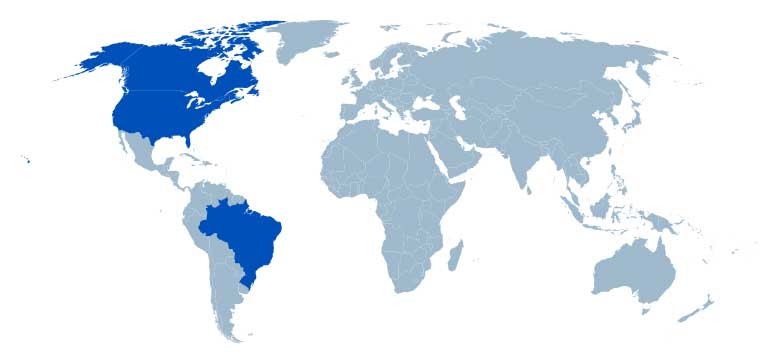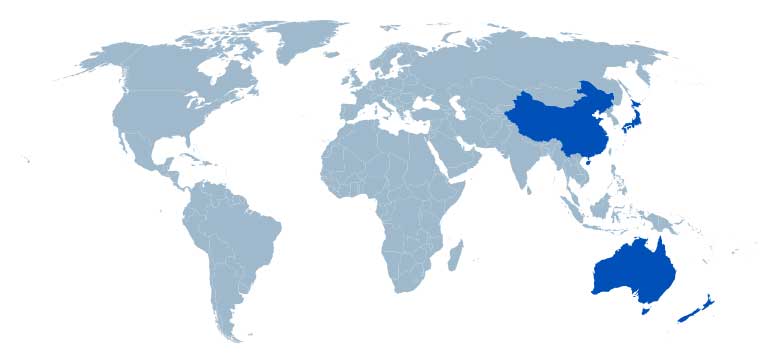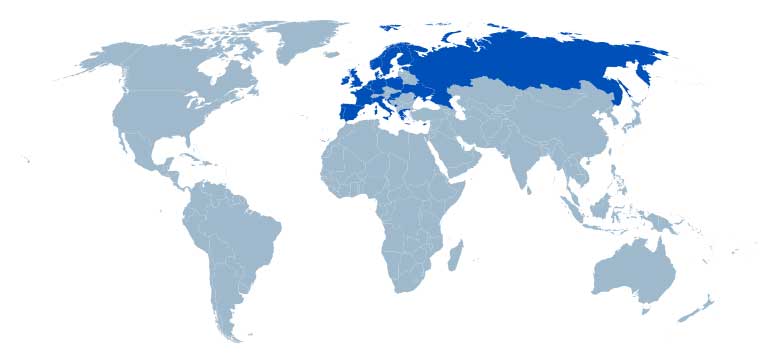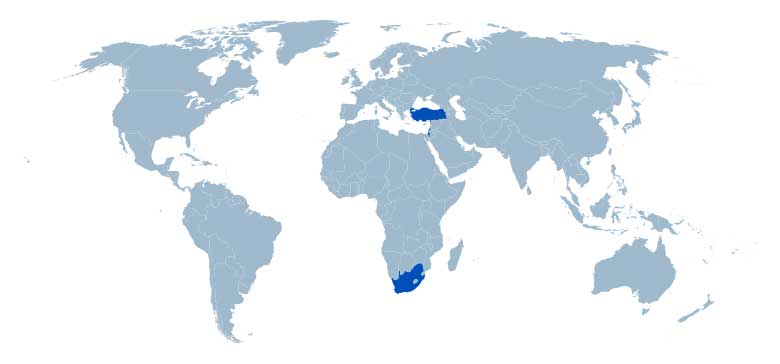Getting to know your substrates
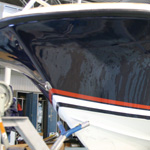
Fiberglass is made from polyester resin reinforced with chopped or woven glass fibers. Once the resin sets to a hard matrix the resulting laminate is strong and rigid. The smooth external appearance is due to a protective gelcoat, made from polyester resin. Despite its obvious advantages, experience has shown that fiberglass is susceptible to the effects of sunlight and the marine environment. There are two problems to be aware of:
Fiberglass is prone to osmosis!
Gelcoats fade!
Eventually the gelcoat will begin to fade as a result of exposure to UV (Ultra Violet) light in sunlight.
Polishing with wax may delay this, but eventually a coat of paint will be needed to restore color and protect the surface.
Working with aluminum
Aluminum is an excellent material for boats.However, aluminum alloys are prone to corrosion if untreated or damaged. When new alloys are exposed, an oxide layer forms on their surface. The oxide layer does not protect the alloy in the long term when exposed to damp marine environments. Attention to the preparation of a new hull and the maintenance of an existing hull can save you considerable difficulties and costly repairs in the future.
Aluminum inspection
Periodically the paint system will need to be removed in areas of stress and any corrosion treated. Careful inspection on an annual basis of all weld seams will allow for early identification of the occurrence of this problem.
Aluminum compatibility
Aluminum reacts with some copper-based antifouling paints causing serious corrosion. Therefore antifoulings containing metallic copper or cuprous oxide should never be used on aluminum. Only use copper free or copper thiocyanate based antifouling on aluminum, firstly ensuring it is primed properly.
Working with woods
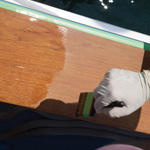
Wood is the only natural boat building material used today, and although it generally requires more maintenance than the more common fiberglass vessels, a well cared for boat, built of wood, will always attract admiring glances when she sails into view.The fibrous nature of wood means that it has a tendency to absorb moisture from the atmosphere,and swell and contract to varying degrees depending on the type of construction. For a varnish or paint coating to stay intact it will need to be quite flexible in nature. The moisture content in wood can allow the growth of fungal spores, which leads to rotting and decay. Wood can also be subject to attack by marine borers, which eat the wood fibers. Wood therefore needs to be protected by good quality preservatives and coatings. Many different woods can be used, which can differ immensely.
Hardwoods
Hardwood comes from slow growing deciduous trees. They have a tighter grain than soft woods. This tight grain has good strength characteristics across the wood as well as along its length, making it particularly suitable for decorative application, as well as boat building.
Mahogany: Mahogany will last for many years in a marine environment with little protection as the seawater has an antiseptic quality. The same is not true with regard to fresh water, which will lead to rot and decay if allowed to permeate the wood fibers. Mahogany should, therefore, be protected from freshwater at all times and wherever possible washed down with seawater.
Teak and Iroko: Teak and iroko are particularly oily woods with a natural resistance to rot and decay. Additionally they contain silica, which gives them hard-wearing characteristics.
Oak: Ferrous metals, such as steel and iron, react badly with oak, due to the tannin in the fibers. This will cause dark staining and even chemical attack on the metal by the tannic acid, which is formed.
Softwoods
The grain in these woods is long, straight and generally wider spaced than hardwoods as these trees grow faster. This means that their strength is mostly along their length so they are used in such applications as masts and spars, tillers, rubbing strakes, oars and planked hulls.
Working with steel
Steel is a heat-treated alloy based on iron with a lower carbon content and small quantities of other elements. The high strength of steel in relation to the plate thickness and the ability to cut and bend it into many different shapes makes it suitable material for building hulls and superstructures. Fastenings such as bolts and rivets are often a different alloy for added strength, while fittings contain added chromium, to make the steel‘stainless’ and resistant to rust. Having stated that steel is a good material for building boats, it is important to be aware of some of the characteristics of the material in order to ensure good results.
Steel corrodes!
The most common form of corrosion in steel is rust. For the reaction to take place, water must also be present. The marine environment is therefore an ideal place for rust to occur.
Steel stretches!
The most common form of corrosion in steel is rust. For the reaction to take place, water must also be present. The marine environment is therefore an ideal place for rust to occur. Steel stretches! Due to the high flexibility and strength of steel it is hard to break, but impact damage may well result in a dent owing to the metal stretching and deforming locally. This can present problems for a protective coating, which may not be so flexible.
How to prepare bare substrates
All surfaces should be thoroughly degreased andfree from any sanding debris prior to the applicationof any paint to the surface.
Aluminum Degrease with solvent. Sand well using 60-120 grit(aluminum compatible) paper. Clean thoroughly and allow to dry. Prime using an Interlux primer as soon as possible (within 8 hours) following the product recommendations provided in the paint systems guides.
Lead Degrease with solvent. Sand well using 120 grit paper or power wire brush. Clean thoroughly and allow to dry. Prime using an Interlux primer following the product recommendations provided in the paint systems guides.
Zinc/Galvanized Steel Degrease with solvent. Sand well using 60-120 grit(aluminum compatible) paper. Clean thoroughly and allow to dry completely. Prime using an Interlux primer following the product recommendations provided in the paint systems guides.
Steel Degrease with solvent. Grit blast to Sa 2.5 – near white metal surface. If grit blasting is not possible,grind the metal surface with 24-36 grit abrasive discs to a uniform, clean, bright metal surface with a 50-75 micron anchor pattern. Use angle grinder on small areas. Clean thoroughly and allow to dry completely. Prime using an Interlux primer following the product recommendations provided in the paint systems guides.
Stainless Steel Light grit blast to produce a profile of 50 microns, clean thoroughly and allow to dry completely prior to application of an Interlux primer following the product recommendations provided in the paint systems guides.
Bronze Clean thoroughly and abrade to bright metal using 80 grit paper. Take care when abrading bronze propellers, as excessive abrading can alter the profile of the propeller causing it to be out of balance. Clean thoroughly and allow to dry completely before applying products recommended for application direct to bronze.
Cast Iron Degrease with solvent. Grit blast to Sa 2.5. If grit blasting is not possible, grind the metal surface with24-36 grit abrasive discs to a uniform clean surface with a 50-75 micron anchor pattern. Use an angle grinder on small areas or a wire brush, prepare to a minimum St.3 according to ISO8501-1. Clean thoroughly with solvent and allow to dry completely. Ensure that all evidence of corrosion (e.g. iron oxide and iron sulphide) is removed prior to the application of an Interlux primer, following the product recommendations provided in the paint systems guides.
Fiberglass Degrease with solvent. Sand well using 80-220grit paper. Clean thoroughly and allow to dry completely. Prime using an Interlux primer following the product recommendations provided in the paint systems guides.
Bare Wood/Plywood Sand smooth with 80-180 grit paper and then 280grit paper. Remove sanding dust by brushing or dusting. Wipe down thoroughly with solvent and allow to dry completely, to ensure any residual sanding dust is removed, before applying products recommended for application direct to wood.
Oily woods e.g. teak Ensure that the surface is thoroughly degreased using a recommended solvent to ensure all oils are removed. Sand smooth with 80-180 grit paper and then 280 grit paper. Remove sanding dust by wiping with solvent, to ensure any residual dust is removed. Ensure the surface is completely dry before applying products recommended for application direct to wood (see paint systems guides).
Paint your boat like a pro
Find the best products to keep your boat in great condition
Get all the support you need to paint with confidence
Benefit from our continuous innovation and scientific expertise



